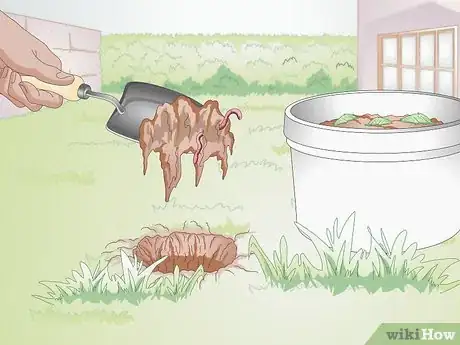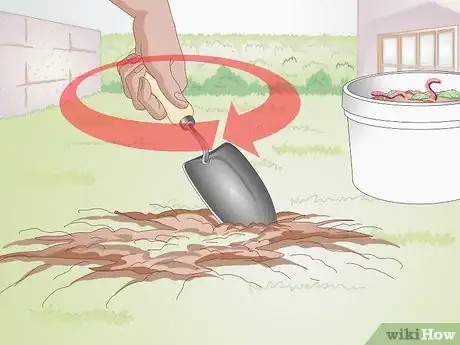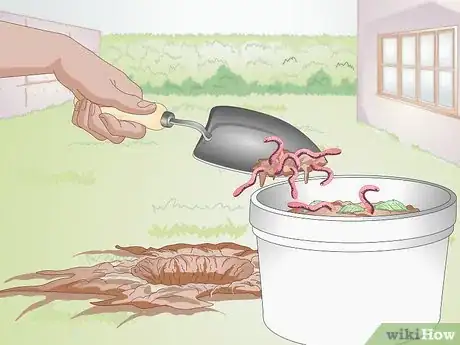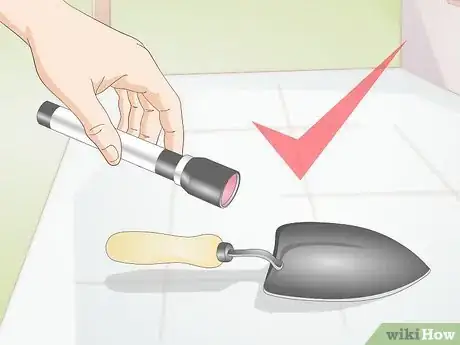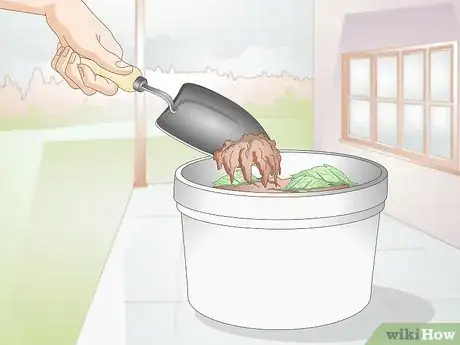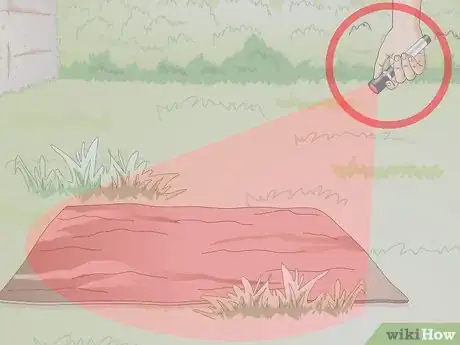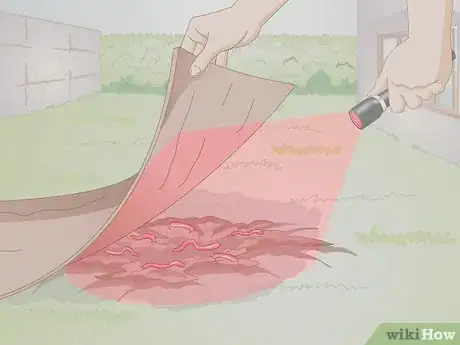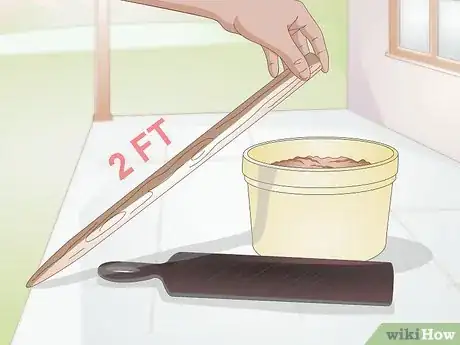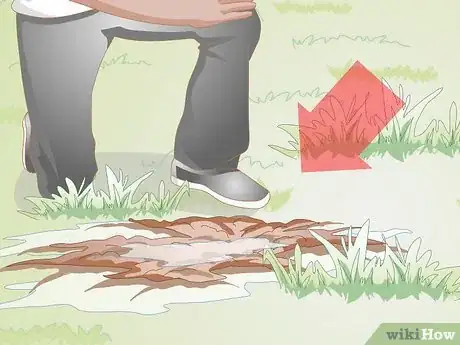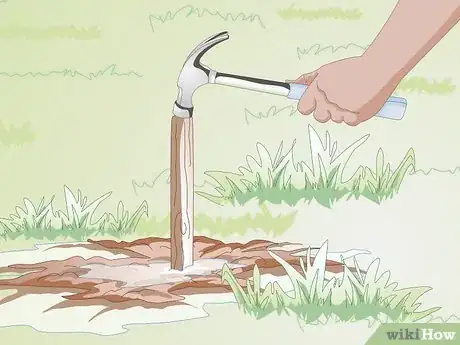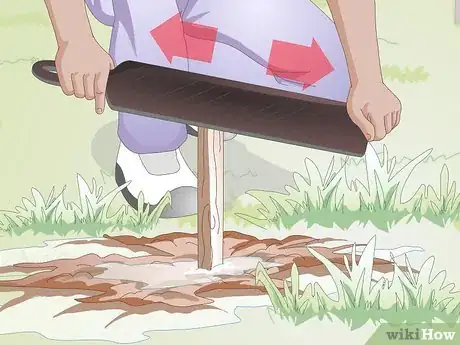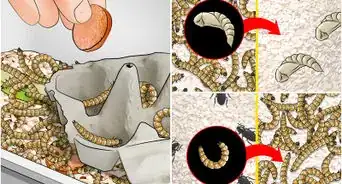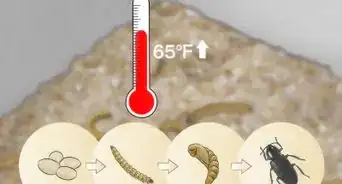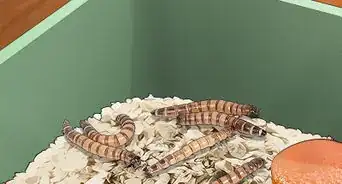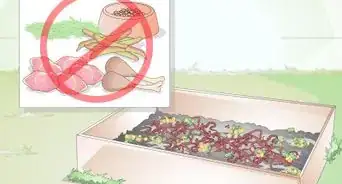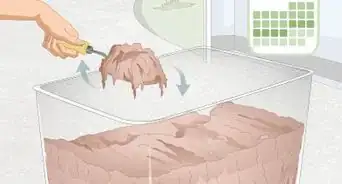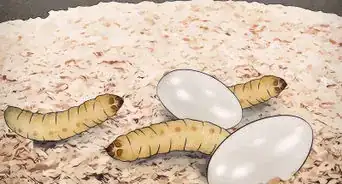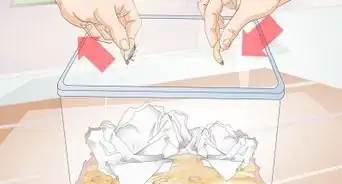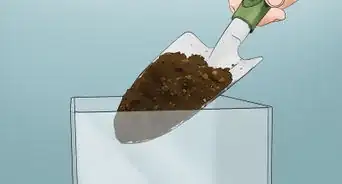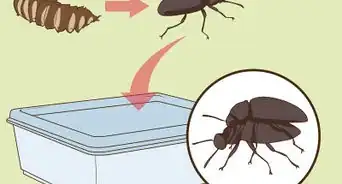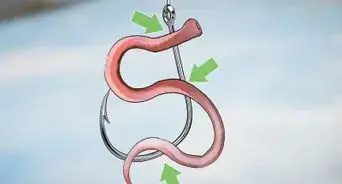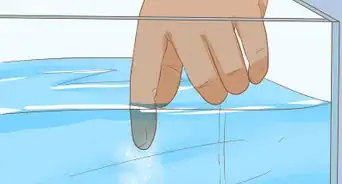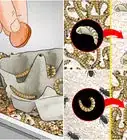This article was co-authored by wikiHow Staff. Our trained team of editors and researchers validate articles for accuracy and comprehensiveness. wikiHow's Content Management Team carefully monitors the work from our editorial staff to ensure that each article is backed by trusted research and meets our high quality standards.
wikiHow marks an article as reader-approved once it receives enough positive feedback. In this case, 88% of readers who voted found the article helpful, earning it our reader-approved status.
This article has been viewed 364,958 times.
Learn more...
Earthworms are often used as bait for anglers, but they’re also integral to healthy gardens, and are great in compost areas because they break down organic matter quickly and turn it into nutrient-rich soil. Worms are active at different times for different reasons, so if you know when to look for them, gathering a few for your garden, worm farm, or compost pile will be simple. Not only is it free to gather earthworms, but it’s a great activity for the kids to participate in as well.
Steps
Digging for Worms
-
1Assemble your equipment. You will need: a shovel or spade and a container filled with moist soil and leaves.
- An ideal time to look for earthworms is when you are already digging up soil, such as during gardening, fence building, or digging a foundation. If you go deeper than just the surface, you will find different types of earthworms, including nightcrawlers.
- Dress for gardening. You’ll be digging through soil for worms, so you’re likely going to get dirty. You may want to wear old clothes, knee pads, gardening gloves, gardening boots or shoes.
-
2Dig for worms. Select a patch of ground in your backyard, garden, or forest and begin digging a small hole. As you lift the soil out, sift through it for worms and collect any that you find. An excellent place to dig for worms is near a stream or water source.
- You can also try digging in a community garden or forest floor, but you should avoid digging up earth in privately owned golf courses, fields, and public parks.
- Be as quiet as possible so your vibrations don’t spook the worms.
- Be sure to look under rocks, logs, and other items lying on the ground.
Advertisement -
3Carefully dig around worms that resist. Worms are equipped with setae, which are bristles that help them move through the earth. This may make it difficult to pull worms directly out of the ground. Dig around a worm that is trying to burrow back into the ground, being careful not to cut the worm. Once you’ve loosened the soil, it will be easy to pluck the worm out and put it in your storage container.
-
4Continue digging until you’ve collected your worms. When you’ve exhausted a patch of ground, replace the soil and begin digging a new hole a couple feet away. Repeat the digging and searching process, and replace the soil when you are finished.
Hunting for Worms at Night
-
1Place a large piece of wet cardboard on your lawn. Do this the night before your worm hunting. This will attract worms.
-
2Assemble your tools. Earthworms spend their days burrowed underground in the soil, they surface at night in order to feed on organic matter.[1] Therefore, you can collect earthworms at night without having to dig like you would in the day. You won’t need any fancy tools for earthworm hunting, but you should take:[2]
- A flashlight with a dull or red light in it. Earthworms can’t see, but they can sense light, and will shy away from a bright flashlight.
- A shovel or small spade to move soil around or turn it over.
-
3Prepare your worm container. You can use a container made of Styrofoam, metal, plastic, glass, or cardboard. Fill it three-quarters of the way with moist soil, and cover the soil with dead, wet leaves. The leaves will help keep the soil moist and provide the worms with food.
- A butter tub, coffee can, jar, ice cream tub, or old bucket will do. Make sure your container is empty and clean before storing worms in it.
- Worms need oxygen, so poke holes in the lid that are large enough to let air pass through, but not so large that the worms can stretch and wriggle their way out.
-
4Wait for the sun to set. When it does, go to your front yard, backyard, or garden. You can also try a forest, field, or even a golf course. Walk softly, slowly, and quietly. Worms cannot hear, but they can sense vibrations.
- You can also hunt for worms during the day if it has been raining. Worms need moisture to survive, so they often come above ground to migrate during rainstorms or when the ground. After the next storm, go outside and look for worms to collect on the lawn, sidewalk, and driveway.[3]
-
5Use your flashlight to look for worms. Gather those you find and store them in your container. You will have to work quickly, because if the worms sense you coming, the will wriggle back into the soil.
- Earthworms are most active in the spring and fall, because they don’t like extreme cold or hot. However, they will also be active during summer nights.
- Look for pellets or small piles of soil on the surface of the ground that are evidence of earthworm activity.
-
6Look under the cardboard. Also turn over stones, logs, and leaves. Worms will be attracted to the moist soil underneath things in the ground, so turn over anything lying on the ground to find worms.
- Use your spade or shovel to turn over leaves and the top layer of soil if you’re having trouble finding worms.
Coaxing Worms With Vibrations
-
1Assemble your tools and equipment. Worm grunting, sometimes called worm charming, is the process of using vibrations to entice earthworms out of the ground. For this activity, you will need your worm container, a wooden stake that’s about two feet long with one pointed end and one flat end, and a one-inch thick metal file (known as a rooping iron).[4]
- Alternatively, you can use a handsaw if you don’t have a rooping iron, but you will likely also need a hammer to drive the stake into the ground.
-
2Select your location. A shady field or wooded area with damp soil is the best location for worm charming. Somewhere near a running stream or small body of water is even better.
-
3Drive the stake into the earth. Use the rooping iron or hammer to drive the stake about halfway into the ground.
-
4Run the rooping iron over the stake. To create vibrations that will drive the worms from the ground, you need to recreate the vibrations that burrowing moles make as they dig through the ground looking for worms to feed on.[5] Run the file (or the blade of the handsaw) over the flat top of the stake at a medium pace.
- As the earthworms sense the vibrations, they will make their way to the surface to escape the predator they think is near. Be ready to gather the worms as they surface and collect them in your container.
Community Q&A
-
QuestionHow long does it take to gather the worms?
 Community AnswerAnywhere from 5 minutes to 30 minutes, depending on how many worms you're looking for, the type of soil, and the time of day/season.
Community AnswerAnywhere from 5 minutes to 30 minutes, depending on how many worms you're looking for, the type of soil, and the time of day/season. -
QuestionWhat do worms eat?
 Community AnswerEgg shells, lettuce, dead leaves, and lots of other stuff.
Community AnswerEgg shells, lettuce, dead leaves, and lots of other stuff. -
QuestionIs it gay to search for worms?
 Community AnswerNo, it is not. It is also not appropriate to use the term "gay" in a condescending manner.
Community AnswerNo, it is not. It is also not appropriate to use the term "gay" in a condescending manner.
References
- ↑ http://animals.nationalgeographic.com/animals/invertebrates/earthworm/
- ↑ http://www.education.com/science-fair/article/earthworms-and-light/
- ↑ http://www.accuweather.com/en/weather-news/why-do-earthworms-surface-afte/28916
- ↑ http://kobreguide.com/worm_harvesting_with_iron_and_wood/
- ↑ http://modernfarmer.com/2014/08/worm-grunting/
- ↑ http://www.songbirdgarden.com/store/info/infoview.asp?documentid=214
About This Article
To gather earthworms at night, start by laying a wet piece of cardboard down on the ground. Then, once the sun sets and it's dark outside, look under the cardboard to see if any worms came up to the surface to eat it. If you don't see any worms, try using a garden shovel to turn over the top layer of soil to find some. Once you've found some, use the shovel to transfer them to a bucket or container filled with soil and dead, wet leaves. To learn how to go digging for worms, read on!

